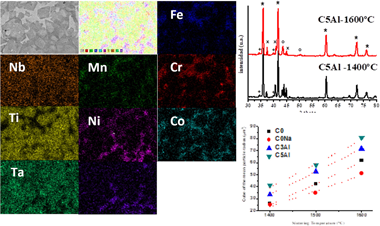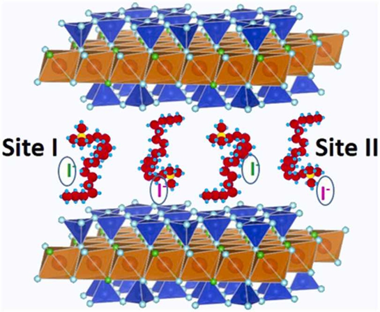Artículos SCI
2021
2021
Reactividad de Sólidos
Unravelling the optimization of few-layer graphene crystallinity and electrical conductivity in ceramic composites by Raman spectroscopy
Muñoz-Ferreiro, C; Lopez-Pernia, C; Gallardo-Lopez, A; Poyato, RJournal of the European Ceramic Society, 41 (2021) 290-298
Show abstract ▽
Zirconia composites with few-layer graphene (FLG) were prepared by two powder processing routines-ultrasonic agitation or planetary ball milling-and spark plasma sintered at 1250 and 1300 degrees C. An in-depth study of the crystallinity of FLG, in terms of presence and nature of defects, was performed by Raman spectroscopy, revealing enhanced FLG crystallinity after sintering. This enhancement was more noticeable in the composites sintered at the highest temperature, with lower amount of structural defects and amorphous carbon. However, remaining amorphous carbon was detected in the composites prepared by planetary ball milling even after sintering at the highest temperature, resulting in lower electrical conductivities. Optimum results in terms of electrical conductivity were achieved for the composites prepared by ultrasonic agitation and sintered at 1300 degrees C, with electrical percolation limit below 2.5 vol% FLG and high electrical conductivity (678 S/m for 5 vol% FLG), as result of the enhanced FLG crystallinity after sintering.
Diciembre, 2021 | DOI: 10.1016/j.jeurceramsoc.2021.09.025
Reactividad de Sólidos
Advanced parametrisation of phase change materials through kinetic approach
Lizana, J; Perejon, A; Sanchez-Jimenez, PE; Perez-Maqueda, LAJournal of Energy Storage, 44 (2021) 103441
Show abstract ▽
Phase change materials (PCM) have been widely investigated for heat storage and transfer applications. Numerous numerical simulation approaches have been proposed for modelling their behaviour and predicting their performance in thermal applications. However, simulation approaches do not consider the kinetics of the phase transition processes, compromising the accuracy of their predictions. The phase change is a kinetically driven process in which both the reaction rate and the reaction progress depend on the heating schedule. This work evaluates and parametrises the influence of kinetics in the melting and crystallisation behaviour of a well-known PCM, PEG1500, and compares potential discrepancies with common phase change parametrisation alternatives. The kinetic dependence was experimentally evaluated through differential scanning calorimetry (DSC). The kinetic parameters required for modelling the kinetics of the processes were determined by both model-free and model-fitting procedures following ICTAC (International Confederation for Thermal Analysis and Calorimetry) recommendations. Then, the phase transition was parametrised through a kinetic model and compared with three conventional phase transition models: linear without hysteresis, non-linear without hysteresis, and non-linear with hysteresis. The statistical comparison between models demonstrates the higher accuracy of the kinetic approach to correctly represent the partial enthalpy distribution of latent heat storage materials during alternative phase change rates, obtaining a coefficient of determination (R-2) of 0.80. On the other hand, the accuracy of kinetic-independent models is limited to the range from 0.40 to 0.61. The results highlight the high discrepancies of conventional models compared to the kinetic approach and provide criteria and guidelines for efficient kinetic modelling of phase change in heat transfer evaluations.
Diciembre, 2021 | DOI: 10.1016/j.est.2021.103441
Reactividad de Sólidos
Fabrication and characterization of FeCoNiCrMn,(Al) high entropy alloy based (Ti,Ta,Nb)(C,N) cermet
Real, C; Alcala, MD; Trigo, I; Fombella, I; Cordoba, JMInternational Journal of Refractory Metals & Hard Materials, 101 (2021) 105694
Show abstract ▽

From nanostructured mechanically synthesized powder a set of FeCoNiCrMn,(Al) based (Ti,Ta,Nb)(C,N) cermets were fabricated and sintered by a pressureless procedure. Highly dense cermets were obtained, and the nature of chemical change, microstructure, mechanical properties and coarsening kinetic of ceramic phase were characterized by image analysis, microindentation, scanning electron microscopy and X-ray diffraction. The design of the material was performed using a set of three different chemical cermet composition and three different sintering temperatures, or comparative purposes.
Diciembre, 2021 | DOI: 10.1016/j.ijrmhm.2021.105694
Materiales Coloidales
White, blue, violet, and other colors from Tm3+/Tb3+/Eu3+ co-doped polymorph SrAl2O4 films, deposited by ultrasonic spray pyrolysis technique
Calderon-Olvera, RM; Garcia-Hipolito, M; Alvarez-Fregoso, O; Alvarez-Perez, MA; Baez-Rodriguez, A; Ramos-Brito, F; Garcia-Velasco, AC; Falcony, COpticalls Materials
Show abstract ▽
SrAl2O4: Tm3+, SrAl2O4: (Tb3+; Eu3+) and SrAl2O4: (Tb3+; Eu3+; Tm3+) films were deposited by ultrasonic spray pyrolysis (USP) method at 550. C and subsequently heat-treated at 800 degrees C. XRD characterization showed a monoclinic/hexagonal polymorph phase of these films with orthorhombic Sr4Al14O25 as secondary phase. The incorporation of Tm3+ ions in strontium aluminate host lattice generated emissions of blue color for photoluminescence and violet color for cathodoluminescence. The violet emission was associated to the electronic transition from I-1(6) energy level of Tm3+. Photoluminescence of the SrAl2O4: (Tb3+; Eu3+) films resulted in two different colors, white emission was observed when excited with 210 nm and bluish-white emission was achieved by exciting with 275, and 286 nm. When three dopant ions (Tm3+; Tb3+; Eu3+) were incorporated inside strontium aluminate host lattice, it was observed (exciting under 252 nm) white photoluminescence emission (x = 0.3377, y = 0.3294); for excitation wavelengths (lambda(exc)) = 262, 315 and 375 nm, emissions in different shades of blue-green were achieved. Quantum efficiencies between 48 and 57% were obtained.
Diciembre, 2021 | DOI: 10.1016/j.optmat.2021.111737
Materiales de Diseño para la Energía y Medioambiente
Designed organomicaceous materials for efficient adsorption of iodine
Osuna, FJ; Pavon, E; Pazos, MC; Alba, MDJournal of Environmental Chemical Engineering, 9 (2021) 106577
Show abstract ▽

The anionic iodine I-129 has a significant contribution to overall long-term dose resulting from the nuclear waste storage and its immobilization by clay barrier is crucial. Organoclays have been tested as ideal adsorption materials, being the clay layer charge and the length and type of organic molecules the most relevant parameters affecting the adsorption. In this work, a family of designed organomicas are explored in term of iodine adsorption capacity. Their adsorption capacities were always higher than that of the traditional clays and organoclays. C-18-M4 shows a maximum monolayer adsorption capacity one order of magnitude higher than natural organoclays, with a free energy typical of physical adsorption and adsorption sites of high affinity. However, its surface is not homogeneous in terms of stability constant according to the Scatchard adsorption parameters. Hence, this study can provide a guidance for the design and construction of ultrahigh-capacity iodine adsorbents.
Diciembre, 2021 | DOI: 10.1016/j.jece.2021.106577
- ‹ anterior
- 62 of 410
- siguiente ›














